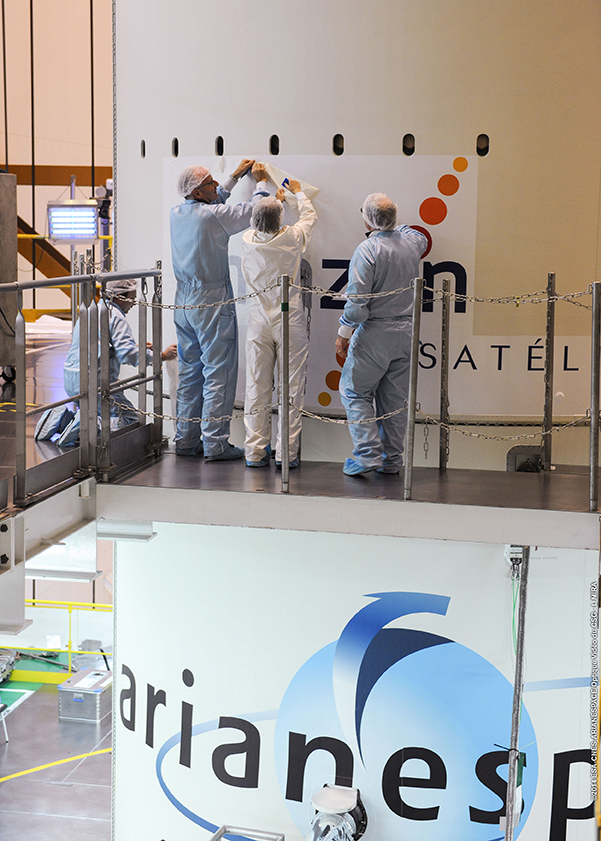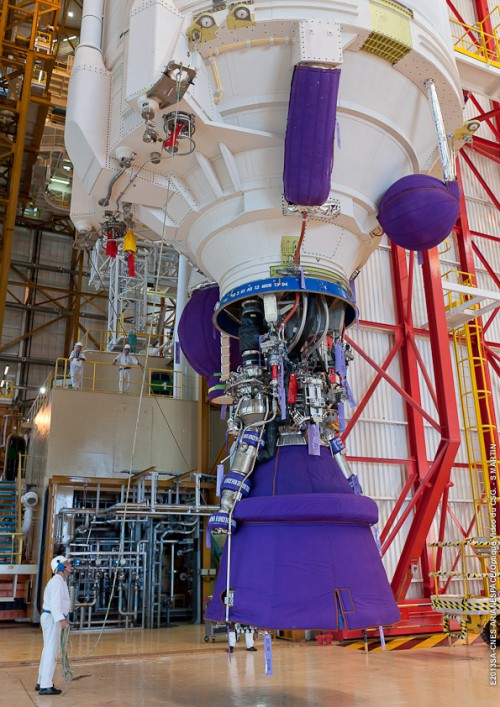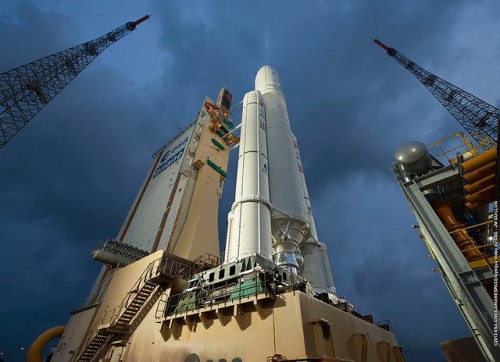
More than three months later than originally planned, Arianespace—the Paris, France-headquartered launch services organization—is poised to deliver the Astra 5B and Amazonas 4A communications satellites into geostationary transfer orbit on Mission VA-216 on Friday, 21 March. Liftoff of the Ariane 5 vehicle is targeted to occur during a 57-minute “window,” which opens at 7:05 p.m. GFT (10:05 p.m. GMT). As noted in an earlier AmericaSpace article, VA-216 was leapfrogged into orbit by the VA-217 mission to deliver the ABS-2 and Athena-Fidus satellites into orbit on 6 February. This makes Friday’s mission the second Ariane 5 launch by Arianespace in 2014.
VA-216 was originally scheduled for launch in mid-December, and assembly operations of the Ariane 5’s 100-foot-tall (30-meter) “cryotechnic main stage” got underway at the Guiana Space Centre in Kourou, French Guiana, in early October. By the following month, it had been installed onto its operational launch table in the Launcher Integration Building (BIL). The next phase of preparation was the attachment of Ariane 5’s twin solid-fueled boosters, followed by the cryogenic upper stage and the Vehicle Equipment Bay (VEB), which contains the rocket’s computerized “brain.” However, on 19 December, Arianespace announced that VA-217 would fly ahead of VA-216. In making this announcement, Chairman and CEO Stéphane Israël thanked the clients of both missions “for their trust” and praised the “excellent collaboration between our teams,” as well as highlighting Arianespace’s own “commitment and flexibility.”
It was reported that VA-217 would fly on 23 January, with VA-216 following on 19 February. During this period, however, the nozzle of the second-stage cryogenic engine for VA-217 was inadvertently bumped and managers opted to replace it. This created a two-week delay until early February, which, in turn, pushed the VA-216 launch into early March. Postponed again by the need for additional “payload checks,” Arianespace finally announced 21 March as the next available launch opportunity.

Mission VA-216 will mark the 73rd flight by an Ariane 5, which first flew in June 1996, and the 217th overall flight by a member of Arianespace’s rocket family since the maiden voyage of an Ariane 1, way back in December 1979. Flight readiness reviews of the two-stage Ariane 5 and its payloads occurred yesterday (Wednesday), and the vehicle was slated for rollout to the ELA-3 (Ensemble de Lancement Ariane) launch zone today (Thursday), about 24 hours ahead of the opening launch attempt. Following rollout, Arianespace engineers will set to work establishing electrical, fluid, and other connections between the booster and the pad facilities.
Assuming that final preparations for Friday’s launch go smoothly, the loading of 260,000 pounds (118,000 kg) of liquid oxygen and 50,000 pounds (22,700 kg) of liquid hydrogen for the Vulcain-2 engine of the first stage will get underway at T-4 hours and 50 minutes. The propellant tanks will be pressurized for flight at T-4 minutes, and the 171-foot-tall (52-meter) vehicle will transition to internal power supplies. In the final seconds, systems aboard the rocket will assume primary command of all critical functions and the guidance system will be unlocked to Flight Mode.
The French-built Vulcain-2 will roar to life at T-0, producing 300,000 pounds (136,000 kg) of thrust, although liftoff will not occur for another 7.5 seconds, as a series of computer-controlled health checks are undertaken. When all is verified to be well, the twin side-mounted solid-fueled boosters—each punching out 1.4 million pounds (635,000 kg) of propulsive yield and together generating 92 percent of the thrust to get Ariane 5 off the pad—will ignite and VA-216 will be committed to its mission.
The stack will rise vertically for about five seconds, after which the two computers inside the VEB will initiate a combined pitch and roll program maneuver, actively rotating the vehicle onto the correct flight azimuth to insert the Astra 5B and Amazonas 4A primary payloads into orbit. One minute into the ascent, the vehicle will go supersonic and pass through “Max Q,” the period of maximum aerodynamic stress on the airframe. The two solid-fueled boosters will be jettisoned at T+142 seconds, parachuting into the Atlantic Ocean about 300 miles (480 km) east the launch site. Meanwhile, Ariane 5 will by now have reached a velocity of over 1,200 mph (1,900 km/h) and will continue to climb under the impulse of its Vulcain-2 engine.
Three and a half minutes into the flight, the bullet-like payload shroud will be detached, exposing the twin satellite cargoes to the space environment for the first time. Shutdown of the Vulcain-2 is expected about 8 minutes and 53 seconds after launch, and the cryotechnic main stage will descend to a splashdown off the coast of Africa, in the Gulf of Guinea. Meanwhile, the second stage—powered by a restartable, 6,100-pound-thrust (2,770-kg) Aestus engine—will ignite to pick up the baton for the final push into orbit. By now, the rocket will be over 105 miles (170 km) high and traveling at more than 4,300 mph (6,900 km/h). Sixteen minutes later, having reached a velocity of 5,700 mph (9,170 km/h), Geostationary Transfer Orbit (GTO) will be attained. By this point, about 25 minutes will have elapsed since launch from the Guiana Space Centre. The low point (or “perigee”) of the target orbit will be 155 miles (250 km), whilst the high point (or “apogee”) is expected to be 22,205 miles (35,736 km). Astra 5B will be deployed into orbit first, at T+27 minutes and 3 seconds, followed by Amazonas 4A at T+34 minutes and 37 seconds. The VA-216 mission is expected to last about 47 minutes from liftoff to the conclusion of payload-deployment and avoidance-maneuver operations.

In a similar fashion to previous Ariane 5 missions with dual satellites, Astra 5B and Amazonas 4A will ride aboard the upper and lower decks of the Système de Lancement Double Ariane (SYLDA) payload dispenser. The former will occupy the upper portion of the SYLDA, with the latter sitting “beneath” it. Astra 5B was built by EADS Astrium, following a November 2009 contract awarded by Luxembourg-based satellite provider SES. This contract also encompassed the construction of the Astra 2E satellite, which was launched last September aboard the Proton-M “Return to Flight” mission from Baikonur Cosmodrome in Kazakhstan. The contract envisaged the launch of four new satellites—Astra 2E, Astra 2F, Astra 2G, and Astra 5B—between 2012-2014. Two of the three Astra 2 satellites have already been launched, with 2G currently scheduled to fly in 2014. The arrival of Astra 5B in its orbital position at 31.5 degrees East longitude is expected to extend SES’s transponder capacity and geographical reach “over Eastern European and neighboring markets for Direct-to-Home, Direct-to-Cable and contribution feeds to Digital Terrestrial Television networks.”
With Astra 5B deployed first from the SYLDA, the turn will then come for Amazonas 4A, which has been built by Orbital Sciences Corp., under contract to the Hispasat organization, headquartered in Madrid, Spain. The satellite will be situated at 61 degrees West longitude to cover the entire landmass of South America, from Venezuela and Colombia in the north to Argentina and Chile in the south. With the higher-powered Amazonas 4B scheduled for launch in 2015, the two satellites were described by Orbital as “examples of Hispasat’s strong commitment to the Latin American market.”
With the completion of VA-216, the remainder of 2014 promises to be busy for Arianespace, with further Ariane 5 missions planned in May and July. The first of these flights will deliver the Measat 3B and Optus 10 communications satellites into orbit, whilst the second will loft the final Automated Transfer Vehicle (ATV)-5 toward the International Space Station (ISS) on behalf of the European Space Agency (ESA).
Want to keep up-to-date with all things space? Be sure to “Like” AmericaSpace on Facebook and follow us on Twitter: @AmericaSpace
Missions » Astra 5B »



